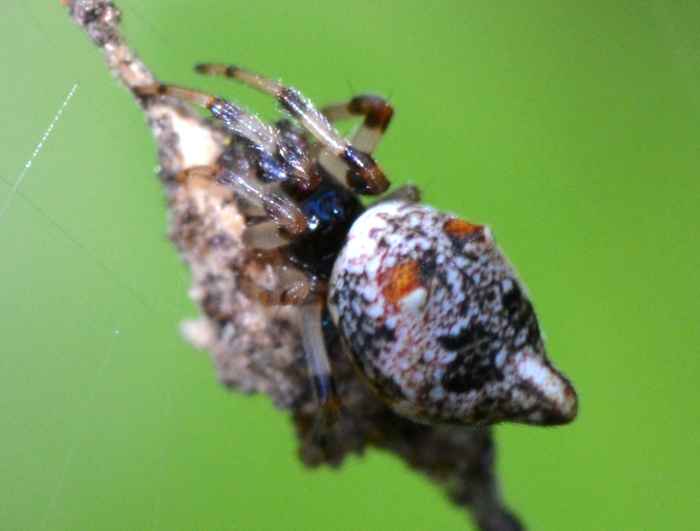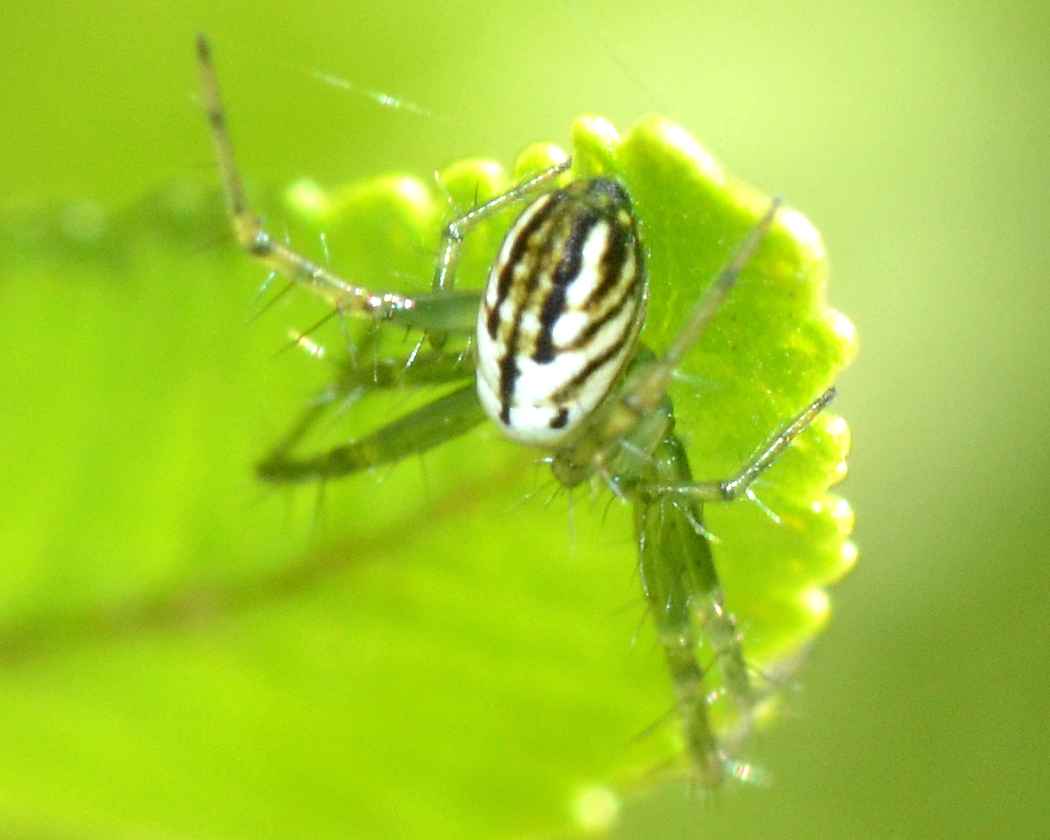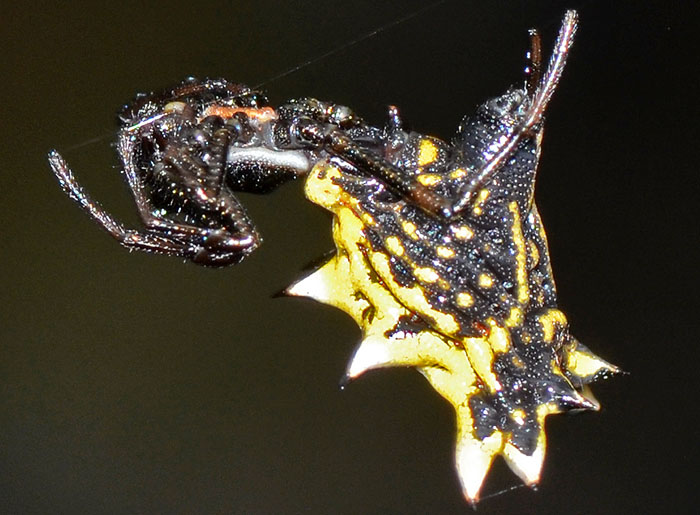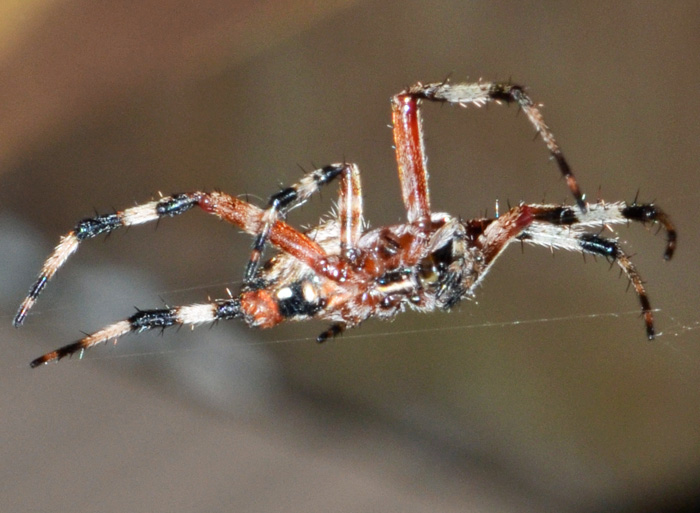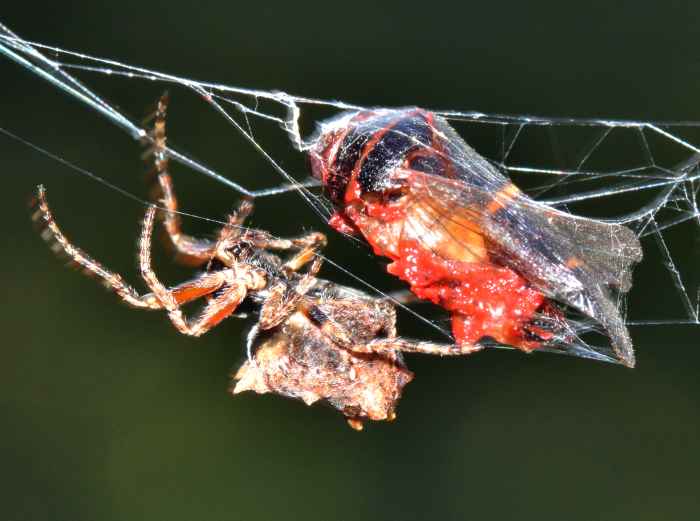 Araneus alboventris. | I found this colorful, little spider hiding at a hard to see place on my truck. Most of its body and legs are greenish yellow but its golden yellow abdomen has a dark brown (or even black) patch bordered by a crimson red border. The typical habitats are meadow shrubs.
bug guide (these photos): https://bugguide.net/node/view/1577665 Dondale et al. The Orb-Weaving Spiders of Canada and Alaska (2003): https://tinyurl.com/Araneus-alboventris | ||
 Argiope sp. (Garden Spider). | A young garden spider on its characteristic zigzagging web. These thicker features are called "stabilimentum" and do a pretty good job camouflaging the animal. They might also protect the web from destruction by birds (and me). This spider belongs to the genus Argiope which has four species in Florida. bug guide: http://bugguide.net/node/view/2007 | ||
 Cyclosa turbinata (Trashline Orbweaver) ♀. | The Trashline Orbweaver (Cyclosa turbinata) decorates its web with dead bodies of insects and other debris. This decoration forms a vertical line and the spider blends into it. Females of C. turbinata differ from the similar C. conica "by being smaller in size and having a pair of anterior dorsal humps." Notice that I rotated this photo by 45 degrees.
bug guide (this photo): http://bugguide.net/node/view/566759 | ||
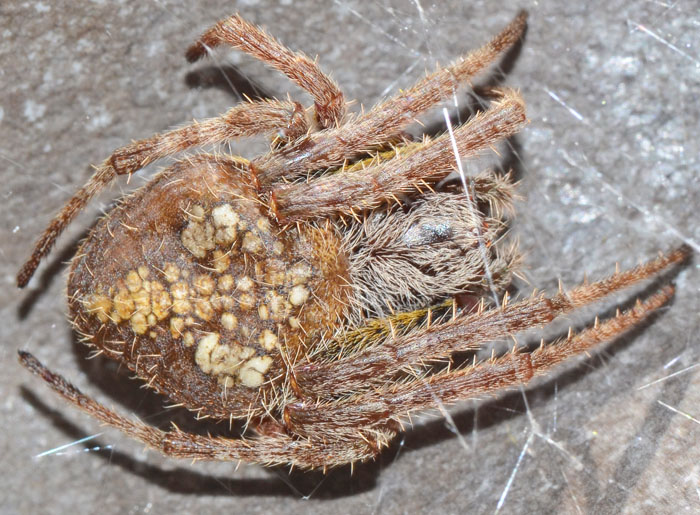 Eriophora ravilla (Tropical Orb Weaver). | Tropical Orb Weavers can show a great variety of colors and patterns, although many are dull brown. This one features a number of bright pigment spots that create a cross-like pattern. The species is mainly found along the Gulf coast. bug guide (this photo): http://bugguide.net/node/view/1087367 H. W. Levi (article): http://www.bio-nica.info/Biblioteca/Levi1970Araneidae.pdf | ||
 Eustala sp. (Humpbacked Orbweaver). | A Humpbacked Orbweaver (Eustala sp.) 13 species in the US. Its web was suspended between two small magnolia trees at a height of about 6'. I found it around 7:30 pm and it had just started rebuilding its orbweb for the night. bug guide (this photo): http://bugguide.net/node/view/582441 | ||
 Gasteracantha cancriformis (Spinybacked Orbweaver) ♀. | Other common names of Gasteracantha cancriformis include Crab Spider, Jewel Spider, and Smiley Face Spider. The six characteristic (spine-like) projections are often red and typically larger than in this specimen. In Florida specimens, the dorsum is white with black spots; elsewhere the dorsum can also have other colors. They often live in or around trees and are most common in Fall. Their lifespan is short and ends with reproduction. bug guide (this photo): http://bugguide.net/node/view/569551 | ||
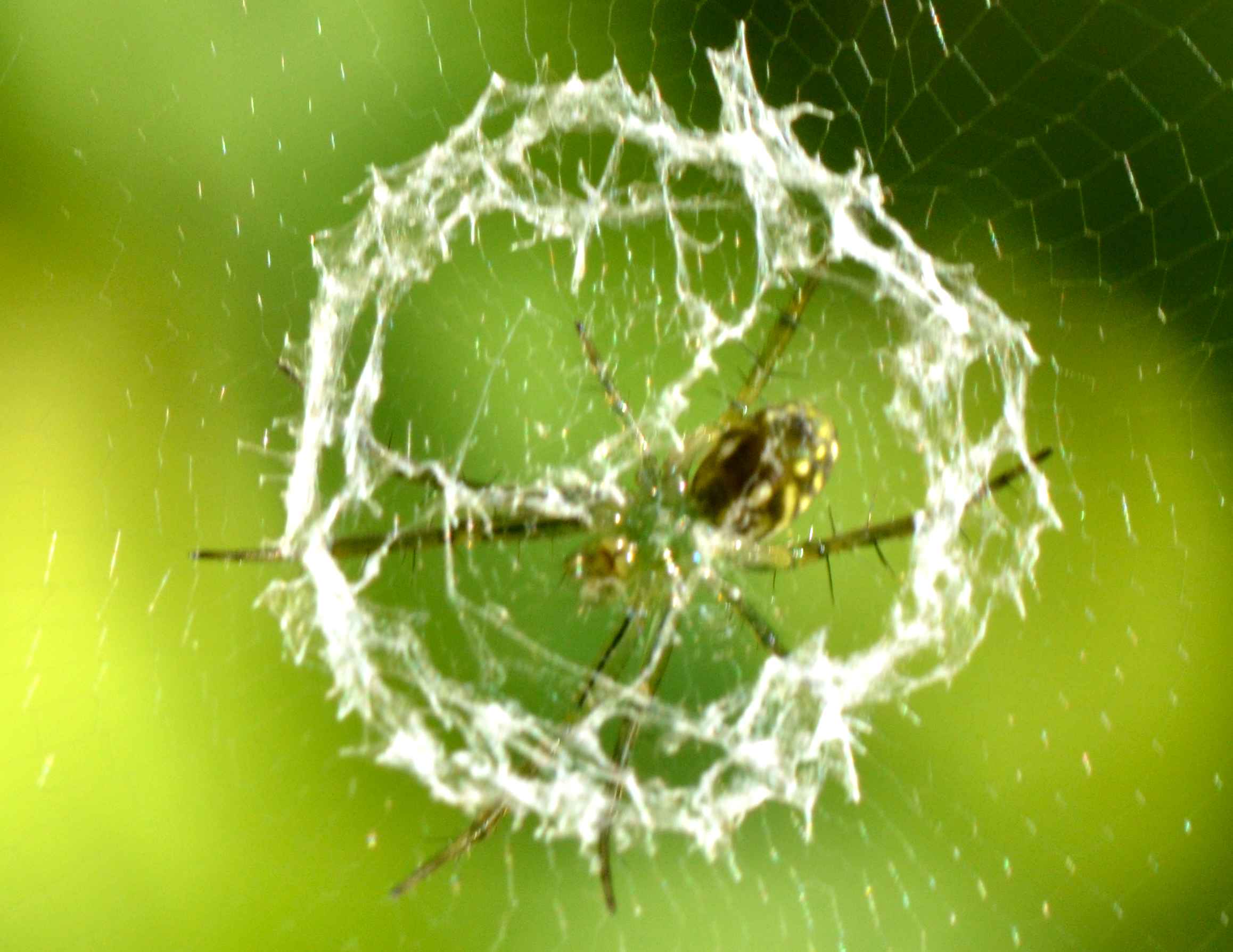 Mangora gibberosa (Lined Orbweaver). | The circular white ring in this web is reminiscent of the stabilimenta produced by the garden spider Argiope. Wikipedia states that stabilimenta evolved independently at least nine times. This web belongs to the Lined Orbweaver (Mangora gibberosa). The small photo shows the owner after being chased off the web into a neighboring fern.
bug guide (this photo): http://bugguide.net/node/view/564222 wikipedia (stabilimenta): http://en.wikipedia.org/wiki/Web_decoration | ||
 Micrathena gracilis (Spined Micrathena) ♀. | Females of Micrathena gracilis have ten spines on their chunky abdomen. They are typically white or pale yellow, which makes this yellow specimen a bit unusual. Males looks very different. July and August appear to be the prime time for finding this spider. It spins a moderately large, very tightly coiled web, often in wooded or brushy areas. Despite its fierce appearance, it is completely harmless to humans.
bug guide (these photos): https://bugguide.net/node/view/1575860 wikipedia: https://en.wikipedia.org/wiki/Spined_micrathena | ||
 Neoscona crucifera (Barn Spider). | Neoscona crucifera are common spiders in much of the US and prefer moist woodlands. They are typically nocturnal but females can be found also during the day. Usually they build thier webs at dusk and remove them at dawn. The UF link offers detailed information including a comparison to the similar species N. domiciliorun. The specimen in this photo appears to be a juvenile. bug guide (this photo): http://bugguide.net/node/view/649072 UF: http://edis.ifas.ufl.edu/in569 | ||
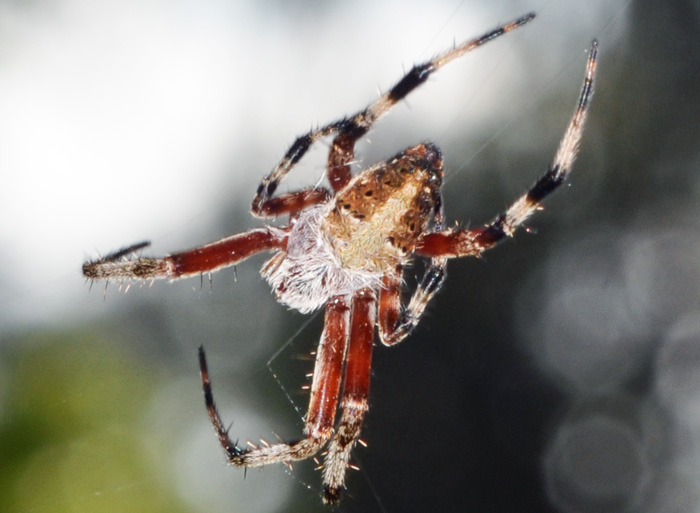 Neoscona domiciliorum (Spotted Orbweaver). | Neoscona domiciliorum builds its web at dusk and takes it back down around dawn. However, I found this one near our trash can around 2 pm. Spider jet lag?
bug guide (these photos): http://bugguide.net/node/view/85426 | ||
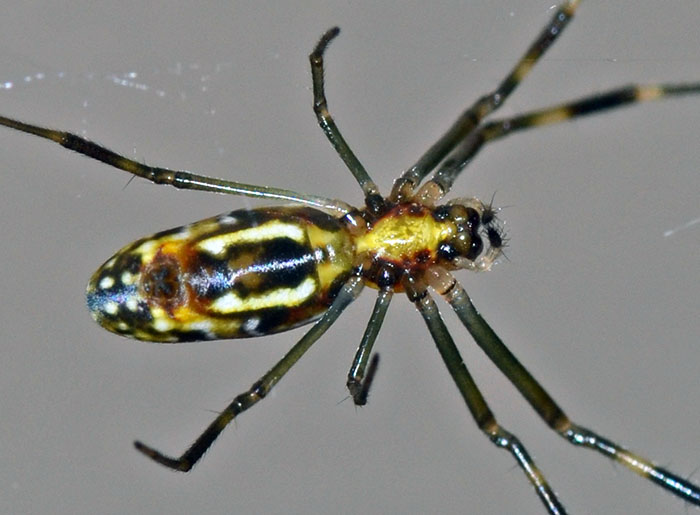 Nephila clavipes juveniles (Banana Spider). | A baby banana spider (aka Golden Orb Weaver). This species makes its home in the southeastern US and is--despite the large size of the adult females (2" without legs)--fairly harmless (but bites might trigger allergic reactions). I found this little specimen near our house wall sharing a web with an Orchard Orbweaver. Young banana spiders do not build the characteristic yellow-colored webs. Their webs are vertical, elliptical orbs that lack the portion of the orb over the center. bug guide (this photo): http://bugguide.net/node/view/1374155 wikipedia: https://en.wikipedia.org/wiki/Golden_silk_orb-weaver | ||
 Nephila clavipes (Golden Silk Orbweaver). | Finally a good photo of a grown-up banana spider. I found this specimen on the day of hurricane Irma's landfall in Florida. It had built a huge, yellowish web spanning at least four feet on the north-side of our house. I wonder how it'll do while Irma passes Tallahassee. Everyone is nervous here to say the least.
By the way, people have made clothes from the spider silk. At the World Fair of 1900, there were two bed hangings on display and in the early 2000s Nicholas Godley collected the silk of 1.2 million Golden silk orb-weavers to produce a shawl. The anchor silk has a tensile strength that exceeds that of steel by a factor of eight. bug guide: http://bugguide.net/node/view/2023 | ||
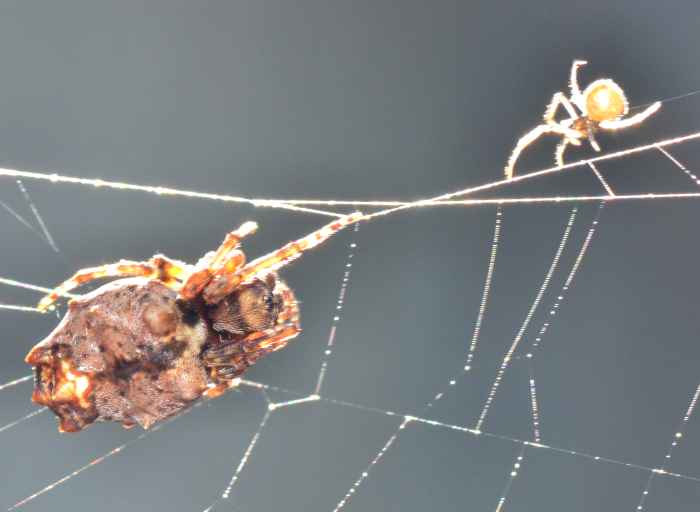 Wagneriana tauricornis (?) (Orbweaver (nonspecific)). | The web span about 1-1.5 m between a small ligustrum and some other plant at a height of 1 m. Most of the time the large spider had its legs curled up and looked like a small leaf or dirt. I'll post more information once I am sure about the identification.
bug guide (these photos): http://bugguide.net/node/view/565170 J. H Comstock Spider Book (Doubleday: Garden City, New York, 1912, pp. 460): http://alturl.com/29uky Bull. Museum Comp. Zool. Harvard Coll. vol. 147: http://alturl.com/55ze9 |


